中非合作论坛第五届部长级会议——北京行动计划(2013年至2015年)双语
中国与非洲的经贸合作(2013)

中国与非洲的经贸合作(2013)文章属性•【公布机关】国务院新闻办公室,国务院新闻办公室,国务院新闻办公室•【公布日期】2013.08.29•【分类】政府白皮书正文中国与非洲的经贸合作(2013)(2013年8月)中华人民共和国国务院新闻办公室目录前言一、推动贸易可持续发展二、提升投融资合作层次三、加强农业与粮食安全合作四、支持非洲基础设施建设五、注重非洲民生与能力发展六、促进多边框架下的合作结束语附录1 中非合作论坛第四届部长级会议经贸举措落实情况附录2 中非合作论坛第五届部长级会议中国政府宣布的未来三年中非重点合作领域前言当前,国际形势发生深刻复杂变化,新兴和发展中经济体成为推动世界经济发展的重要力量。
中国与非洲国家顺应形势变化,在中非合作论坛框架内不断深化中非新型战略伙伴关系,大力推动经贸合作,积极探索符合中非实际的共同发展之路。
目前中国已成为非洲最大贸易伙伴国,非洲成为中国重要的进口来源地、第二大海外工程承包市场和第四大投资目的地。
中非经贸合作的发展,促进了非洲国家民生的改善和经济的多元化发展,为中国经济社会发展提供了有力支持,也为促进南南合作与世界经济的平衡发展作出了积极贡献。
通过中非双方共同努力,中非经贸合作基础更加坚实、机制更加完善,不断涌现新的合作契合点和增长点。
特别是2013年3月,中国国家主席习近平访问非洲,宣布一系列支持非洲发展的新举措,为推动中非经贸关系迈上新台阶注入了强大动力。
2010年,中国政府发布了白皮书,介绍了中非经贸合作的有关情况。
这里,就近些年来中非经贸合作取得的进展再作一介绍。
一、推动贸易可持续发展近年来,在全球经济复苏乏力的背景下,中非贸易仍然持续了较快发展的态势。
2009年,中国成为非洲第一大贸易伙伴国。
此后两年多时间里,中非贸易规模迅速扩大。
2012年,中国与非洲贸易总额达到1984.9亿美元,同比增长19.3%。
其中,中国对非洲出口额853.19亿美元,增长16.7%;自非洲进口额1131.71亿美元,增长21.4%。
中非合作论坛北京行动计划2018

中非合作论坛—北京行动计划(2019-2021年)2018-09-07 13:07:21 来源:外交部网站1. 序言2. 政治合作2.1 高层互访与对话2.2 磋商与合作机制2.3 立法机关、协商机构、政党、地方政府交往2.4 中国与非洲联盟及非洲次区域组织3. 经济合作3.1 农业、粮食安全与食品安全3.2 产业对接与产能合作3.3 基础设施建设3.4 能源资源合作3.5 海洋经济3.6 旅游3.7 投资与经济合作3.8 贸易3.9 金融4. 社会发展合作4.1 发展合作4.2 医疗与公共卫生4.3 教育与人力资源开发4.4 减贫经验交流4.5 科技合作与知识共享4.6 生态保护和应对气候变化5. 人文合作5.1 文化5.2 新闻与媒体5.3 学者与智库5.4 民间交往5.5 青年与妇女6. 和平安全合作6.1 军队、警察与反恐6.2 反腐败、领事、移民、司法与执法7. 国际合作8. 中非合作论坛机制建设1. 序言1.1 2018年9月2日至4日,中非合作论坛北京峰会暨第七届部长级会议在北京召开。
来自中国和53个非洲国家的国家元首、政府首脑、代表团团长、非洲联盟委员会主席(以下称“双方”)以及外交部长和负责经济合作事务的部长分别出席了峰会和部长会。
1.2 双方满意地回顾了中非关系发展历程,高度评价中非合作论坛,认为论坛成立18年来,日益成熟高效,不断丰富中非关系内涵,促进中非合作全面深入发展,引领和带动了国际对非合作,并一致认为应继续维持论坛现行机制。
1.3 双方对中非“十大合作计划”及《中非合作论坛—约翰内斯堡行动计划(2016—2018年)》各项后续行动得到全面、有效落实感到振奋,决心本着《关于构建更加紧密的中非命运共同体的北京宣言》精神,共同推进“一带一路”合作,共同建设面向未来的中非全面战略合作伙伴关系,共筑更加紧密的中非命运共同体,更好造福中非人民。
1.4 双方认为,中国是最大的发展中国家,正在致力于实现“两个一百年”奋斗目标,实现中华民族伟大复兴的中国梦,非洲是发展中国家最集中的大陆,正在全面推进落实非盟《2063年议程》,致力于建设一体化、繁荣、和平的非洲,双方发展理念相通,发展战略契合,发展优势互补。
《中非合作论坛北京峰会宣言》(全文)

《中非合作论坛北京峰会宣言》(全文)2006/11/05我们,中华人民共和国和48个非洲国家的国家元首、政府首脑和代表团团长,于2006年11月4日至5日在北京举行中非合作论坛峰会。
我们高度评价在中华人民共和国同非洲国家开启外交关系50周年之际举行的此次峰会。
我们本着“友谊、和平、合作、发展”的宗旨,回顾了半个世纪以来中非之间的真挚友谊和团结合作,探讨了新形势下中非合作的共同目标和发展方向,讨论取得了积极成效。
认识到经过双方共同努力,2000年成立的中非合作论坛已成为双方开展集体对话的重要平台和务实合作的有效机制,决心进一步发挥其作用。
为此,我们重申坚持中非合作论坛已通过的各项文件所确立的宗旨和目标。
我们认为,当前国际形势正经历着复杂、深刻的变化,人类社会相互依存日益加深,求和平、促发展、谋合作成为时代的潮流和各国的优先目标。
主张根据和平共处五项原则以及所有倡导多边主义和国际关系民主化的国际准则发展友好合作关系;强调尊重和维护世界的多样性,世界各国不分大小贫富强弱应彼此尊重、平等相待、和睦相处;不同文明和发展模式应相互借鉴、相互促进、和谐共存。
在经济全球化趋势深入发展的情况下,主张加强南南合作和南北对话,呼吁世界贸易组织重启“多哈回合”谈判,推动全球经济均衡、协调和可持续发展,实现各国共享成果、普遍发展、共同繁荣。
主张联合国以及其他各类多边体系进行改革,更好地服务于国际社会所有成员;主张通过改革加强联合国作用,充分发挥联合国大会的职能,更加重视发展问题;主张优先增加非洲国家在联合国安理会和其他各机构的代表性和充分参与。
我们认为,中国作为世界上最大的发展中国家坚持走和平发展道路,非洲作为发展中国家最集中的大陆致力于稳定、发展和振兴,是对世界和平与发展事业的重大贡献。
非洲国家对中国经济快速发展深感鼓舞并表示祝贺,希望中国国家建设取得更大成就;重申坚持一个中国立场,支持中国和平统一大业。
中国高度评价非洲在维护地区和平、促进区域合作、加快经济和社会发展方面取得的进步;赞赏非洲国家和非洲联盟等地区组织及次地区组织为此发挥的积极作用;重申支持非洲国家联合自强,自主解决非洲问题,支持非洲地区组织和次地区组织推动经济一体化的努力,支持非洲国家实施“非洲发展新伙伴计划”。
中非合作论坛第五届部长级会议——北京行动计划(2013年至2015年)双语
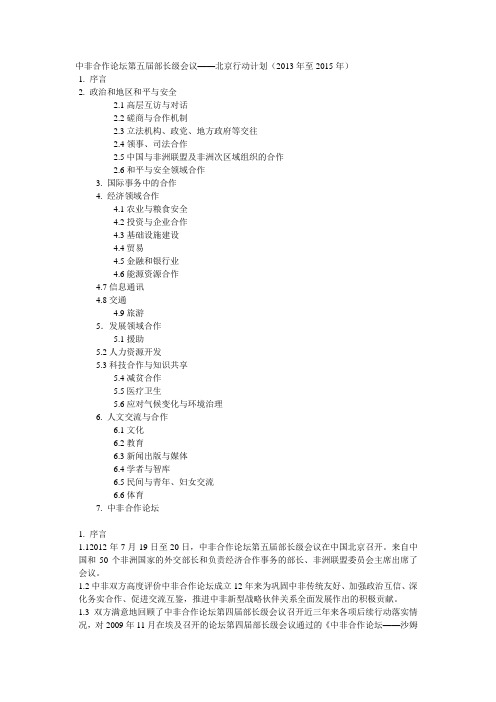
中非合作论坛第五届部长级会议——北京行动计划(2013年至2015年)1. 序言2. 政治和地区和平与安全2.1高层互访与对话2.2磋商与合作机制2.3立法机构、政党、地方政府等交往2.4领事、司法合作2.5中国与非洲联盟及非洲次区域组织的合作2.6和平与安全领域合作3. 国际事务中的合作4. 经济领域合作4.1农业与粮食安全4.2投资与企业合作4.3基础设施建设4.4贸易4.5金融和银行业4.6能源资源合作4.7信息通讯4.8交通4.9旅游5.发展领域合作5.1援助5.2人力资源开发5.3科技合作与知识共享5.4减贫合作5.5医疗卫生5.6应对气候变化与环境治理6. 人文交流与合作6.1文化6.2教育6.3新闻出版与媒体6.4学者与智库6.5民间与青年、妇女交流6.6体育7. 中非合作论坛1. 序言1.12012年7月19日至20日,中非合作论坛第五届部长级会议在中国北京召开。
来自中国和50个非洲国家的外交部长和负责经济合作事务的部长、非洲联盟委员会主席出席了会议。
1.2中非双方高度评价中非合作论坛成立12年来为巩固中非传统友好、加强政治互信、深化务实合作、促进交流互鉴,推进中非新型战略伙伴关系全面发展作出的积极贡献。
1.3双方满意地回顾了中非合作论坛第四届部长级会议召开近三年来各项后续行动落实情况,对2009年11月在埃及召开的论坛第四届部长级会议通过的《中非合作论坛——沙姆沙伊赫行动计划(2010年至2012年)》得到全面、有效执行感到高兴,重申将继续从战略高度和长远角度看待中非关系发展,不断深化中非新型战略伙伴关系。
1.4为落实会议成果,规划今后三年中非在各领域的合作,围绕“继往开来,开创中非新型战略伙伴关系新局面”的主题、本着本届部长会《北京宣言》精神,双方共同制定并一致通过本行动计划。
2. 政治和地区和平与安全2.1高层互访与对话重申高层互访与对话对促进双边关系发展、深化中非新型战略伙伴关系具有十分重要的意义。
中非合作论坛北京峰会召开携手开辟互利共赢新路径

中非合作论坛北京峰会召开携手开辟互利共赢新路径中非合作论坛北京峰会将于9月3日至4日举行。
2000年10月10日,“中非合作论坛——北京2000年部长级会议”在人民大会堂开幕,开启了中非集体对话、谋求共同发展的全新尝试。
自2000年成立至今,中非合作论坛已经走过了十八年,目前成员包括中国以及与中国建交的52个非洲国家,还有非盟委员会。
论坛已经成为中国和非洲友好国家集体对话的重要平台和中非务实合作的有效机制。
中非合作论坛框架下,中国政府宣布并已落实的经贸举措多达几十项,包括在非洲国家建立经贸合作区,设立中非发展基金、非洲中小企业发展的专项贷款和中非产能合作基金等等,体现出在不同时期和不同条件下中非经贸合作发展的方向和重点。
2015年12月,在中非合作论坛约翰内斯堡峰会上,中国国家主席习近平提出把中非关系提升为全面战略合作伙伴关系,并宣布自2015年到2018年的三年内,与非洲国家在工业化、农业现代化、基础设施、金融、绿色发展、贸易和投资便利化、贫惠民、公共卫生、人文、和平和安全等领域,实施“十大合作计划”;同时宣布为这些计划的落实提供资金支持总额达到600亿美元。
近年来,中非经贸合作取得巨大发展。
2017年,中非贸易额达到1700亿美元。
相比2000年,即中非合作论坛初创时增长超过了15倍。
中国近几年对非投资合作一直保持在每年30亿美元左右,非洲已经成为中国重要的投资目的地。
截至2017年底,中国对非直接投资的总量超过400亿美元,相较于论坛成立的2000年增长了接近70倍。
中国与非洲国家在金融领域的合作也不断扩展。
中国已经和南非、摩洛哥、埃及等国签署了本币互换协议。
尼日利亚、南非、毛里求斯等非洲国家也将人民币纳入了外汇储备,人民币在肯尼亚实现了同当地货币的自由兑换。
首家中非合资的金融机构中刚非洲银行在刚果(布)经济首都黑角开设分行。
中国是最大的发展中国家,非洲是发展中国家最集中的大陆。
中国和非洲是发展道路上的真诚伙伴,是国际事务中的天然同盟军。
中非贸易投资论坛在北京举行

中非贸易投资论坛在北京举行
无
【期刊名称】《中国工程建设通讯》
【年(卷),期】2007(000)019
【摘要】在中非合作论坛北京峰会成功召开一周年之际,中非贸易投资论坛于11月8日在北京举行。
帮助中国企业了解非洲的贸易和投资机会、规避在非洲经商的风险,是本次中非贸易投资论坛的宗旨。
【总页数】1页(P9)
【作者】无
【作者单位】无
【正文语种】中文
【中图分类】F752.74
【相关文献】
1.中非合作论坛第五届部长级会议在北京举行胡锦涛出席开幕式并发表讲话 [J],
2.中非合作论坛北京峰会举行圆桌会议习近平主持通过北京宣言和北京行动计划[J], 王迪;赵成;李应齐
3.中非合作论坛北京峰会举行 [J], ;
4.中非合作论坛北京峰会举行圆桌会议习近平主持通过北京宣言和北京行动计划[J],
5.中非合作论坛北京峰会举行圆桌会议习近平主持通过北京宣言和北京行动计划[J], 王迪;赵成;李应齐
因版权原因,仅展示原文概要,查看原文内容请购买。
《中非合作论坛》课件

加强中非金融合作,推动非洲金 融机构和企业参与中国“一带一 路”倡议,为基础设施建设提供
融资支持。
鼓励中国企业到非洲投资基础设 施项目,推动非洲经济持续健康
发展。
加强中非教育和文化交流,促进民心相通
扩大中非教育交流,推动双方互派留 学生和访问学者,加强高等教育机构 之间的合作。
加强中非旅游合作,推动ห้องสมุดไป่ตู้方旅游资 源开发和旅游市场开拓,促进旅游产 业的发展。
01
全球经济形势的变化,如贸易保 护主义、单边主义抬头,对中非 合作产生了一定的冲击和影响。
02
中非双方需要加强政策沟通,共 同应对全球经济形势变化带来的 挑战,推动中非合作向更高水平 发展。
中非合作中的安全风险和挑战
中非合作涉及的地区安全形势较为复 杂,存在一些安全风险和挑战,如恐 怖主义、海盗活动等。
成立。
2006年,中非合作论坛北京峰 会暨第三届部长级会议在北京举 行,会议通过《中非合作论坛北
京峰会宣言》。
中非合作论坛的目标和宗旨
目标
致力于建立平等、合作、互利的 新型伙伴关系,推动中非关系全 面、快速发展。
宗旨
平等互利、共同发展、面向未来 、造福人民。
中非合作论坛的组织架构和成员
组织架构
中非合作论坛由中非双方轮流主办,每三年举办一届部长级会议。
THANKS
THANK YOU FOR YOUR WATCHING
成员
中国和与中国建交的53个非洲国家。
02
中非合作论坛的发展历程
中非合作论坛的早期发展
2000年
中非合作论坛构想提
2006年
首届中非合作论坛在北京召开,确定了中非合作 的重要原则和方向
2012年7月时事政治

一、国内部分:1.庆祝香港回归祖国15周年大会暨香港特别行政区第四届政府就职典礼7月1日上午在香港会展中心隆重举行,中共中央总书记、国家主席、中央军委主席胡锦涛出席并发表重要讲话。
胡锦涛强调,中央政府实行“一国两制”、“港人治港”、高度自治方针将毫不动摇,全力支持香港特别行政区行政长官和政府依法施政将毫不动摇,同香港各界人士一道维护和促进香港长期繁荣稳定将毫不动摇。
2.由中国日报社与日本言论NPO共同主办的第八届北京—东京论坛7月2日在日本东京开幕,两国主办方共同发布《东京共识》。
日本首相野田佳彦发来贺词。
国务院原副总理、中国国际经济交流中心理事长曾培炎等出席论坛并发表讲话。
中方代表指出,应促进互信与互惠两大要素更加平衡协调发展,把握大局,合作共赢,弘扬友好,管控分歧,推动中日关系行稳致远。
3.《国务院关于加强食品安全工作的决定》于7月3日发布。
决定明确指出,通过不懈努力,用3年左右的时间,使我国食品安全治理整顿工作取得明显成效,违法犯罪行为得到有效遏制,突出问题得到有效解决;用5年左右的时间,使我国食品安全监管体制机制、食品安全法律法规和标准体系、检验检测和风险监测等技术支撑体系更加科学完善,生产经营者的食品安全管理水平和诚信意识普遍增强,社会各方广泛参与的食品安全工作格局基本形成,食品安全总体水平得到较大幅度提高。
4.国务院总理温家宝主持召开国务院常务会议:7月4日部署2011年度中央预算执行等审计查出问题整改工作,听取全国社会保障资金审计情况汇报。
7月11日研究部署深化流通体制改革加快流通产业发展,讨论通过《节能减排“十二五”规划》,明确了主要任务、支持政策和保障措施。
7月25日决定扩大营业税改征增值税试点范围,研究部署进一步实施促进中部地区崛起战略,加强和改进最低生活保障工作。
7月30日听取鼓励民间投资实施细则制定情况汇报,部署鼓励和支持企业加强技术改造工作。
5.2012年,中国移动启动了TD—LTE扩大规模试验网建设,通过新建和升级的方式,在上海等7个城市建设超过2万个TD—LTE基站。
中非合作论坛—北京行动计划(2025-2027)

中非合作论坛—北京行动计划(2025-2027)文章属性•【缔约国】中非合作论坛•【条约领域】政治,外交,文化教育,科学技术,医疗卫生,工业农业•【公布日期】2024.09.05•【条约类别】其他•【签订地点】北京正文中非合作论坛—北京行动计划(2025-2027)目录1. 序言2. 未来三年中方单方面支持非洲重点举措3. 政治、和平与安全合作3.1 高层互访与对话3.2 政党、立法机关、协商机构、地方交往3.3 中国与非洲联盟3.4 和平安全合作3.5 国际事务合作4. 治国理政,现代化和文明交流互鉴4.1 治国理政经验交流4.2 文明交流互鉴4.3 反腐败合作4.4 智库交流5. “一带一路”合作和非盟《2063年议程》5.1 优先发展基础设施和互联互通5.2 投资和产供链合作5.3 科技合作与知识共享6. 加快实现非洲农业现代化6.1 农业合作和技术转让6.2 减贫与乡村发展合作6.3 粮食安全7. 优先支持非洲工业化、能源和贸易7.1 加快非洲工业化7.2 能源合作7.3 贸易便利化7.4 基础设施建设7.5 数字经济7.6 融资合作8. 支持非洲人才培养和妇女儿童赋权8.1 教育8.2 人才培养8.3 妇女与青年9. 加强可持续发展领域合作9.1 气候变化9.2 生态保护9.3 海洋合作、自然灾害管理及预防10. 社会人文合作与联合国2030年可持续发展议程10.1 卫生健康和非洲药品产业10.2 文化、旅游和体育10.3 新闻与媒体11. 中非合作论坛机制建设1.序言1.12024年9月4日至6日,中非合作论坛北京峰会暨第九届部长级会议在北京召开。
来自中国和53个非洲国家的国家元首、政府首脑、代表团团长、非洲联盟委员会主席(以下称“双方”)以及外交部长和负责经济合作事务的部长分别出席峰会和部长会。
1.2双方赞赏中非合作论坛成立24年来,顺应和平、发展、合作、共赢的历史潮流,克服国际形势变乱交织、全球经济复苏乏力、新冠疫情肆虐等挑战,推动中非友好合作全面深入发展,成为南南合作的高效平台和引领国际对非合作的“金字招牌”。
背景资料 中非合作论坛

根据2002年生效的论坛后续机制程序,中非合作论坛对话磋商机制建立在三个级别上:部长级会议每三年举行一届;高官级后续会议及为部长级会议做准备的高官预备会分别在部长级会议前一年及前数日各举行一次;非洲驻华使节与中方后续行动委员会秘书处每年至少举行两次会议。部长级会议及其高官会轮流在中国和非洲国家举行。2007年9月,中非合作论坛框架下的中非外长级定期政治对话机制正式启动。
自成立以来,中非合作论坛已成为中非双方集体对话和务实合作的有效平台,中非多边、双边合作机制得到进一步加强,中非合作得以在更大范围、更广领域和更高的层次上全面深入发展,特别是2006年召开的中非合作论坛北京峰会暨第三届部长级会议确立了中非政治上平等互信、经济上合作共赢、文化上交流互鉴的新型战略伙伴关系,在中非关系史上具有里程碑意义。
背景资料:中非合作论坛
新华网北京3月24日电 中非合作论坛是中国和非洲国家之间在平等互利基础上的集体对话机制,旨在加强平等磋商、扩大务实合作、促进共同发展。
2000年10月,在中非双方共同倡议下,中非合作论坛——北京2000年部长级会议在北京召开。会议通过了《北京宣言》和《中非经济和社会发展合作纲领》两个历史性文件。中非双方决定在21世纪建立和发展长期稳定、平等互利的新型伙伴关系,建立中非合作论坛机制。中非合作论坛正式成立。迄今,中非合作论坛已相继举行了五届部长级会议,并于2006年召开了中非合作论坛北京峰会。
目前,中国已成为非洲ቤተ መጻሕፍቲ ባይዱ一大贸易伙伴国,非洲是中国第四大海外投资目的地。2012年中非贸易额为1984亿美元,同比增长19%。
【2013福建省质检】福建省2013届高三毕业班质量检测文综试题Word版含答案

2013年福建省普通高中毕业班质量检查文科综合能力测试本试卷分第1卷和第11卷。
第1卷为必考题,第Ⅱ卷包括必考题和选考题两部分。
本试卷共l4页。
满分300分。
考试时间l50分钟。
注意事项:1.答题前,考生务必先将自己的姓名、准考证号填写在答题卡上。
2.考生作答时,请将答案答在答题卡上,在本试卷上答题无效。
按照题号在各题的答题区域内作答,超出答题区域书写的答案元效。
3.选择题答案使用28铅笔填涂,如需改动,用橡皮擦干净后,再选涂其它答案标号。
非选择题答案使用0.5毫米的黑色中性(签字)笔或碳素笔书写,字体工整、笔迹清楚。
4.做选考题时,考生按照题目要求作答,并用28铅笔在答题卡上把所选题目对应的题号涂黑。
5.保持答题卡卡面清洁,不折叠,不破损。
考试结束后,将本试卷和答题卡一并交回。
第Ⅰ卷本卷共36小题,每小题4分,共计l44分。
在每小题列出的四个选项中,只有一项是最符合题目要求的。
图1示意我国某大城市2009年城区地价等值线,读图回答1~2题。
1.中心商务区最有可能分布的区域是A.① B.② C.③ D.④2.与其他区域相比,近年来④地地价涨幅较大的主要原因是A.高附加值产业集聚 B.原有基础设施完善C.外来人口迁入D.逆城市化发展图2示意某流域径流过程的不同环节,读图回答3—4题。
3.图中甲、乙、丙三个环节分别是A.下渗、坡面流、壤中流B.壤中流、下渗、坡面流C.坡面流、下渗、壤中流D.坡面流、壤中流、下渗4.当降水量相同时,下列因素对径流过程的不同环节影响符合实际的是A.地表起伏大,坡面水流慢B.植被覆盖密,截流雨水多C .岩体破碎多,地下径流小D.降水强度大.坡面下渗多L湖原是新疆最大的淡水湖,近年来已演变成微咸水湖。
现在该湖西部沿岸芦苇广布,而东部沿岸几乎没有。
图3示意L湖及周边地区,读图回答5—6题。
5.正确描述甲、乙两河与L湖相互关系的是A.甲河秋季输入L湖泥沙最多 B.甲河流量变化深受L湖影响C.乙河是L湖重要补给水源 D.乙河对L湖具有排盐作用6.对L湖东、西两岸芦苇分布差异影响最小的因素是A.主导风向 B.湖水盐度 C.沿岸坡度 D.土壤肥力图4示意某国2008年人口结构,读图回答7~8题。
2014年白皮书中国的对外援助(中英文对照)
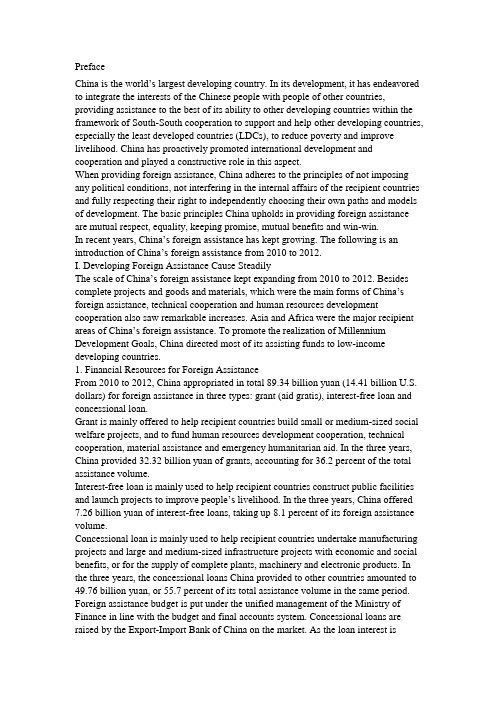
PrefaceChina is the world’s largest developing country. In its development, it has endeavored to integrate the interests of the Chinese people with people of other countries, providing assistance to the best of its ability to other developing countries within the framework of South-South cooperation to support and help other developing countries, especially the least developed countries (LDCs), to reduce poverty and improve livelihood. China has proactively promoted international development and cooperation and played a constructive role in this aspect.When providing foreign assistance, China adheres to the principles of not imposing any political conditions, not interfering in the internal affairs of the recipient countries and fully respecting their right to independently choosing their own paths and models of development. The basic principles China upholds in providing foreign assistance are mutual respect, equality, keeping promise, mutual benefits and win-win.In recent years, China’s foreign assistance has kept growing. The following is an introduction of China’s foreign assistance from 2010 to 2012.I. Developing Foreign Assistance Cause SteadilyThe scale of China’s foreign assist ance kept expanding from 2010 to 2012. Besides complete projects and goods and materials, which were the main forms of China’s foreign assistance, technical cooperation and human resources development cooperation also saw remarkable increases. Asia and Africa were the major recipient areas of China’s foreign assistance. To promote the realization of Millennium Development Goals, China directed most of its assisting funds to low-income developing countries.1. Financial Resources for Foreign AssistanceFrom 2010 to 2012, China appropriated in total 89.34 billion yuan (14.41 billion U.S. dollars) for foreign assistance in three types: grant (aid gratis), interest-free loan and concessional loan.Grant is mainly offered to help recipient countries build small or medium-sized social welfare projects, and to fund human resources development cooperation, technical cooperation, material assistance and emergency humanitarian aid. In the three years, China provided 32.32 billion yuan of grants, accounting for 36.2 percent of the total assistance volume.Interest-free loan is mainly used to help recipient countries construct public facilities and launch projects to improve people’s livelihood. In the three years, China offered 7.26 billion yuan of interest-free loans, taking up 8.1 percent of its foreign assistance volume.Concessional loan is mainly used to help recipient countries undertake manufacturing projects and large and medium-sized infrastructure projects with economic and social benefits, or for the supply of complete plants, machinery and electronic products. In the three years, the concessional loans China provided to other countries amounted to 49.76 billion yuan, or 55.7 percent of its total assistance volume in the same period. Foreign assistance budget is put under the unified management of the Ministry of Finance in line with the budget and final accounts system. Concessional loans are raised by the Export-Import Bank of China on the market. As the loan interest islower than the benchmark interest releas ed by the People’s Bank of China, the difference is made up by the state as financial subsidies.2. Distribution of Foreign AssistanceFrom 2010 to 2012, China provided assistance to 121 countries, including 30 in Asia, 51 in Africa, nine in Oceania, 19 in Latin America and the Caribbean and 12 in Europe. Besides, China also provided assistance to regional organizations such as the African Union (AU).3. Forms of Foreign AssistanceFrom 2010 to 2012, China provided foreign assistance mainly in the following forms: undertaking complete projects, providing goods and materials, conducting technical cooperation and human resources development cooperation, dispatching medical teams and volunteers, offering emergency humanitarian aid, and reducing or exempting the debts of the recipient countries.Complete projects. In total, China undertook the construction of 580 such projects in 80 countries, with infrastructure and agriculture as the focus.Goods and materials. China provided 96 countries and regions with 424 batches of goods and materials, including mainly office supplies, mechanical equipment, inspection equipment, transport vehicles, articles for daily use, medicine and medical devices.Technical cooperation. China completed 170 technical cooperation projects in 61 countries and regions, mainly covering industrial production and management, agricultural planting and breeding, culture and education, sports and physical training, medical and health care, clean energy development, and planning and consultation. Human resources development cooperation. China held 1,951 training sessions for officials and technical personnel and on-the-job academic education programs in China, training a total of 49,148 people from other developing countries.Medical teams. China dispatched 55 teams composed of 3,600 medical personnel to 54 countries to provide stationed or touring medical services, treating nearly seven million patients.Volunteer programs. China sent about 7,000 young volunteers and volunteer Chinese language teachers to over 60 countries.Emergency humanitarian aid. China extended 1.5 billion yuan worth of materials and cash assistance in emergency humanitarian aid to more than 30 countries.Debt relief. China relieved nine LDCs and heavily indebted poor countries, namely, Tanzania, Zambia, Cameroon, Equatorial Guinea, Mali, Togo, Benin, Cote d’Ivoire and Sudan, from 16 mature interest-free loans totaling 1.42 billion yuan.II. Helping Improve People's LivelihoodOne of the important objectives of China's foreign assistance is to support other developing countries to reduce poverty and improve the livelihood of their peoples. China prioritizes supporting other developing countries to develop agriculture, enhance education level, improve medical and health services and build public welfare facilities, and provide emergency humanitarian aid when they suffer severe disasters.1. Promoting Agricultural DevelopmentAgricultural development is crucial to poverty reduction in developing countries. Through establishing agricultural technology demonstration centers, dispatching agricultural experts to provide consultations and conduct technical cooperation, and training technical and managerial personnel on agriculture in other developing countries, China has taken proactive efforts to help other developing countries raise their agricultural productivity to effectively cope with food crises. From 2010 to 2012, China assisted 49 agricultural projects, dispatched over 1,000 agricultural experts to recipient countries, and provided them with a great quantity of machinery, improved varieties of grain, fertilizers and other agricultural materials.Assisting the establishment of agricultural technology demonstration centers. Such centers provide an important platform for China's foreign assistance in agriculture. From 2010 to 2012, China-assisted agricultural demonstration centers were completed in 17 countries, including Benin, Mozambique, Sudan, Liberia, Rwanda, Laos, and East Timor. China passed on advanced and applicable production technologies to local farmers through experiment, demonstration and training. The demonstration center in Liberia promoted hybrid rice and corn planting in areas of nearly 1,000 hectares, and trained over 1,000 local agricultural researchers and farmers. The demonstration center in Rwanda researched, experimented on and demonstrated the adaptability of paddy rice and fungi in the context of the local traditional agriculture, and provided technical training to women's associations, paddy rice growers' associations and other organizations in Rwanda.Dispatching senior agricultural experts and expert teams. Chinese agricultural experts took an active part in the agricultural planning of the recipient countries. The expert team dispatched to Benin provided expertise to the drafting of the country's Agricultural Law and Agricultural Administration Law. The expert teams sent to Botswana and Guinea-Bissau participated in the formulation of the two countries' agricultural development plans. Chinese experts assisted recipient countries in promoting their agricultural development. The expert team helped Lesotho with its application to the World Health Organization for FMD (foot-and-mouth disease) free membership. The expert team to Mauritania assisted the country in drawing up the plan for building its central laboratory for agricultural comprehensive analysis and testing. Chinese experts actively disseminated easy-to-learn agricultural techniques suited to the conditions of recipient countries. The expert team to Botswana promoted the use of plastic mulch incrop production. The expert team to Mali devised and promoted the use of iron harrows as a means of intensive cultivation in the paddy fields.Training technical and managerial personnel on agriculture. Taking the characteristics and actual needs of agricultural development in developing countries into consideration, China provided nearly 300 research and training programs of various forms for almost 7,000 agricultural officials and technicians from the recipient countries. These programs covered a wide range of sectors, including management of crop cultivation, forestry, animal husbandry and fishery, national policymaking on rural development and poverty reduction, food security, and agricultural cooperation among developing countries, and issues concerning the agricultural chain, such astechnology dissemination and the processing, storage, marketing and distribution of agricultural products.2. Improving the Level of EducationFrom 2010 to 2012, China continuously intensified its efforts of foreign assistance in education by way of constructing and maintaining school buildings, providing teaching facilities, training teachers, offering more government scholarships for foreign students to study in China, and assisting with the development of vocational and technical education, for the purpose of helping other developing countries improve their educational level and support their balanced and equitable development in education.Improving teaching and learning conditions. China assisted over 80 projects in relation to educational facilities, including the construction and maintenance of primary and secondary schools, universities and colleges as well as libraries, and has effectively improved the teaching and learning conditions in the recipient countries. China provided large amounts of free educational facilities and materials to the recipient countries, including computers, teaching tools, stationery and sports equipment, and established university online education networks and distance education systems. In this way, China facilitated the efforts of recipient countries to diversify their means and expand the coverage of education.Training teachers. In the three years, China trained over 1,000 educational officials, principals and faculty members from other developing countries by holding over 30 educational training programs, including those for senior administrators of colleges and universities, for higher education management, for vocational education management, for principals and teachers of primary and secondary schools, and for distance education.Supporting vocational and technical education. Thousands of local people have been trained in the China-assisted Friendship Vocational Training Center in Omdurman. To increase its enrolment, China started the upgrading and expansion project of the center. China took active steps to help the recipient countries develop vocational and technical education. From 2001 to 2012, China dispatched over 400 teachers to Ethiopia to train the local teachers working in agricultural vocational and technical education. A total of 1,800 teachers from agricultural vocational schools and 35,000 agricultural technicians received training.Increasing government scholarships to foreign students. From 2010 to 2012, the Chinese government assisted 76,845 foreign students to study in China. To promote regional development, China has continuously increased government scholarships to African students and augmented assistance for students from the ASEAN countries and the Pacific island countries to help under-developed countries in these regions develop their human resources.3. Improving Medical and Health ServicesMedical and health care is a major field where China directs its foreign assistance. From 2010 to 2012, China helped recipient countries improve their medical and health services, raise their disease control and prevention ability, and enhance their public health capacity by constructing hospitals, providing medicine and medicalequipment, dispatching medical teams, training medical workers and conducting exchanges and cooperation on disease prevention and treatment with other developing countries.Constructing medical facilities and providing free medical equipment. China assisted about 80 construction projects of medical facilities, including general hospitals, mobile hospitals, health centers, specialist clinics, and traditional Chinese medicine (TCM) centers, which have effectively alleviated the shortage of medical and health facilities in recipient countries. Moreover, China provided them with about 120 batches of medical equipment and medicine, including color Doppler ultrasound machines, CT scanners, automatic biochemical analyzers, maternal and infant monitors, critical surgical instruments, ICU monitors, and MRI scanners as well as drugs against diseases such as malaria and cholera.Dispatching medical teams. China dispatched 55 medical teams with 3,600 medical workers to nearly 120 medical centers in recipient countries. They trained tens of thousands of local medical staff, which has relieved to a certain extent the shortage of medical services in recipient countries. The training was carried out through demonstrations, lectures, technical courses and academic exchanges, covering such topics as the prevention and treatment of malaria, AIDS, schistosomiasis and other infectious diseases, patient care, the treatment of diabetes and rheumatism, as well as the TCM of acupuncture application, naprapathy, health care methods and Chinese medicines. From 2010 to 2012, more than 100 Chinese medical workers were conferred medals by the recipient countries for their outstanding contributions. Carrying out Brightness Trip activities. Brightness Trip program was actively carried out in both governmental and non-governmental channels to help other developing countries in the treatment of eye diseases. From 2003, China started to send medical teams to provide free surgery for patients with eye diseases in the Democratic People's Republic of Korea, Cambodia, Bangladesh, Vietnam, Pakistan and other Asian countries. In November 2010, a Chinese Brightness Trip medical team arrived in Africa for the first time and carried out operations for over 1,000 cataract patients in countries including Zimbabwe, Malawi, Mozambique and Sudan.Assisting the prevention and control of infectious diseases. From 2010 to 2012, China provided 60 batches of antimalarial medicine, H1N1 influenza vaccine and cholera vaccine free of charge to other developing countries and held training in the prevention and control of infectious diseases, the expenditure for this purpose accumulating to RMB200 million. In 2007, China and the Comoros launched a cooperation program of treating malaria with an artemisinin compound, an effective antimalarial drug, which helped the Comorian island of Moheli reduce its incidence of malaria by 90%. From 2010 to 2012, while making further progress in Moheli, China started promoting the program on the Comorian island of Anjoyan.4. Building Public Welfare FacilitiesTo support other developing countries in improving their people's livelihood and organizing public activities, China actively assisted the construction of urban and rural public welfare facilities, affordable housing and social activity venues, providedrelevant equipment and materials, and conducted technical cooperation on operation and management.Carrying out well-drilling and water-supply projects. China undertook 29 well-drilling and water-supply projects in other developing countries, and drilled over 600 wells. Despite tough natural conditions and the threat of epidemics and terrorism, senior hydrogeologists and engineering geologists from China helped the recipient countries drill wells and undertake water-supply projects. China helped drill 200 fresh water wells in Kara and Centrale of Togo respectively and 38 wells in Darfur, Sudan and Kator of Juba, South Sudan, all of which were equipped with submersible pumps and generator sets. The China-assisted water-supply project in Zinder, Niger has solved the problem of drinking water for hundreds of thousands of local residents. Improving people's living conditions. China assisted 80 residential housing and affordable housing projects in other developing countries, totaling about 600,000 square meters in floor space. China's architects and engineers gave full consideration to the living habits and environmental features of the recipient countries in both external and interior design, and exercised strict quality control while making efforts to reduce costs, for the purpose of providing comfortable and endurable houses to local residents.Assisting the construction of public facilities. China assisted 86 construction projects of public cultural venues, sports venues, office buildings and conference centers in other developing countries. These projects helped enrich local residents' cultural and recreational life, improve the working conditions of local governments, and create a better cityscape. China assisted the rehabilitation of Sri Lanka's Bandaranaike Memorial International Conference Hall, which was a gift from China in the 1970s and took on new dimensions four decades later. China funded the construction of Gabon's 40,000-seat stadium Stade d' Angondje, which hosted the competition final and closing ceremony of the 28th Africa Cup of Nations in 2012. China assisted the construction of the 20,000-square-meter Grand National Theater in Senegal, one of the largest theaters in Africa.5. Humanitarian AidOver the past few years, the world has been frequently hit by severe natural disasters caused by earthquakes, hurricanes, floods and droughts as well as humanitarian crises caused by wars, and many countries have suffered serious casualties and property losses. China has made quick response to the appeals of the international community by providing relief materials or cash aid and dispatching rescue and medical teams as needed, to help the victim countries with disaster relief and post-disaster reconstruction.Providing emergency relief materials or cash aid. From 2010 to 2012, the Chinese government provided RMB1.2 billion worth of emergency relief materials in some 50 batches, including tents, blankets, emergency lights, generators, fuel oil, food, medicine and water filters, to countries affected by natural disasters or humanitarian crises, such as the earthquake in Haiti, floods in Cambodia, earthquake in Myanmar, floods in Pakistan, hurricane in Cuba, the war in Libya, and the turmoil in Syria. In addition, China provided cash aid totaling RMB300 million.Assisting African countries in coping with the food crisis. In 2011 and 2012, the Horn of Africa and the Sahel were stricken by severe droughts and over 30 million people were faced with a serious food shortage. In 2011, the Chinese government provided on three occasions a total of RMB440 million worth of emergency food aid to the countries of the Horn of Africa, such as Ethiopia, Kenya, Djibouti and Somali. In 2012, the Chinese government provided RMB70 million worth of emergency food aid to Chad, Mali, Niger and other countries in the Sahel.Supporting post-disaster reconstruction. In 2010, Pakistan was hit by a severe flood rarely seen in history. The Chinese government promptly carried out rescue work in all aspects and through multiple channels, participated in post-flood reconstruction by helping the victims and rebuilding transportation infrastructure as the country requested. China also provided cash aid to support Pakistan government's compensation packages for victims, and undertook the restoration project of the340-kilometer national highway network destroyed in the flood-stricken areas, enabling 150 million people to have access to the traffic network. In March 2012, a series of blasts occurred in the north of Brazzaville, the capital of the Republic of Congo. China assisted the construction of settlements for people displaced from their homes and actively supported reconstruction after the explosions.Helping improve disaster prevention and relief capacity. China helped recipient countries enhance their emergency rescue, disaster prevention and relief capacity by ways of providing materials and training. Over the three years, China provided over 10 batches of rescue vehicles and equipment, and held 30 training programs on disaster prevention and relief for other developing countries, sharing experience with over 700 officials and technicians.III. Promoting Economic and Social DevelopmentChina has actively helped other developing countries in infrastructure construction, and assisted their efforts in strengthening capacity building and trade development. China has also increased the amount of foreign assistance in environmental protection, helping the recipient countries realize economic and social development.1. Improving InfrastructureIn light of the economic development of different countries, China arranges grants (aid gratis), interest-free loans and concessional loans in a well-proportioned manner to help recipient countries with the much needed infrastructure construction. From 2010 to 2012, China helped build 156 economic infrastructure projects. Exploring its advantages in technology, equipment and materials, and human resources, China effectively cut down investment costs for these projects while ensuring quality. Supporting development of transport system. During the three-year period, China assisted the construction of over 70 transport projects, including roads, bridges, airports and ports. For example, China helped build the third section of the Sika Highway that connects Kenya’s capital Nairobi to its economic hub Sika, thus making a contribution to the road network that links up Kenya, Ethiopia and Tanzania. Sri Lanka’s Mattala Rajapaksa International Airport, built with Chinese assistance, further improves the country’s all-dimensional transport network, and plays a positiverole in promoting links and communication between Sri Lanka and its neighboring areas.Increasing energy supply capacity. China assisted the construction of more than 20 energy projects, including hydropower stations, thermal power plants, power transmission, transformation and distribution grids, and geothermal drilling projects. The Bui Hydropower Station built by China in Ghana boasts the capacity of hydroelectricity generation, farmland irrigation, fisheries development and local tourism. Its completion has not only powered economic and social development in Ghana, but also benefited other areas in Western Africa. The China-assisted power transmission, transformation and distribution grids in Dakar, Senegal now provide power to 150,000 local residents, effectively ensuring power supply to the city, which had been troubled by its ageing grid and sudden blackouts until recently.Promoting the development of information-based societies. China assisted the building of over 60 IT-related projects, including optical cable telecommunication networks, e-government websites, and radio and television frequency modulation transmitters. The telecommunication projects assisted by China in Turkmenistan, Togo and Eritrea provide high-quality and steady telecommunication systems to these countries, and the number of users has grown exponentially. The optical cable transmission networks assisted by China in Cameroon and Tanzania have effectively promoted the application of fiber cables in African nations.2. Strengthening Capacity BuildingBelieving in the ancient Chinese wisdom that “teaching one to fish rather than giving one fish,” China shares its experience and technology with other developing countries through human resources and technical cooperation, as well as through volunteer service, to help other developing countries build their own professional teams and enhance their capacity for independent development.Fast development in human resources cooperation. From 2010 to 2012, China held 1,579 seminars for foreign officials, inviting nearly 40,000 officials from the governments of other developing countries to China. The topics of the seminars covered economics and management, multilateral trade negotiation, politics and diplomacy, public administration, vocational education, and non-governmental organizations. China also held 357 training sessions for about 10,000 technical personnel from other developing countries in the areas of agriculture, health care, telecommunications, industry, environmental protection, disaster relief and prevention, and culture and sports. To help other developing countries improve the ability of their senior management personnel in the public sector, China organized, during the three years, 15 on-the-job academic education programs. Master’s degrees in public administration, education, international relations and international media were granted to 359 officials from 75 developing countries.Extensive technical cooperation. During the three-year period, China sent over 2,000 experts to more than 50 countries to conduct technical cooperation, transfer applicable technique, and help improve these countries’ technical management capacity in agriculture, handcrafts, radio and television, clean energy, and culture and sports. China also dispatched senior planning and consulting experts to other developingcountries to help with the planning of land exploitation, clean energy utilization, river regulation, and economic cooperation. In a technical cooperation program, Chinese experts taught 500 Liberians to weave bamboo and rattan into marketable products. This program has not only created jobs, brought the locals more income and lifted them out of poverty, but also boosted the bamboo and rattan industry in the country. The active role of volunteers. China continued to send volunteers to other developing countries to provide services in language teaching, physical education, computer training, traditional Chinese medicine treatment, agricultural technology, art training, industrial technology, social development and international relief for schools, hospitals, government agencies, farms, and research institutes. A Chinese volunteer to Liberia successfully rescued a newborn with gastroschisis, and was awarded the African Star medal. Volunteers to Ethiopia improved the planting method for melons, and local fruit farmers harvested much more than usual that year; the volunteers also taught the locals to build biogas pits so that they could use clean energy more efficiently.3. Promoting Trade DevelopmentAs an active response to the WTO’s Aid for Trade initiative, China strengthened its assistance in infrastructure construction and production capacity building for other developing countries. China also stepped up zero tariff treatment to these countries, supported their involvement in the multilateral trading system, and provided training for their economic and trade professionals so as to promote the trade development of these countries.Improving trade-related infrastructure. During the three-year period, China assisted the construction of 90 large and medium-sized, trade-related infrastructure projects, effectively improving transportation for foreign trade in the recipient countries and reinforcing their connectivity with other areas. China also provided commodity inspection equipment, transport vehicles and other trade-related supplies and equipment to other developing countries. For example, it provided container inspection equipment to Cambodia, Laos, Myanmar, Ethiopia, Egypt, Chad, Cape Verde, Zambia and Serbia, which has helped these countries improve their commodity inspection capacity and customs clearance ability, as well as effectively combat against smuggling.Improving trade-related production capacity. China assisted the construction of a number of trade-related production programs, which have helped improve to a certain degree the production capacity of the recipient countries, so that they can better meet the needs of the market and improve the import-export mix. In December 2011, during the eighth ministerial conference of the WTO, China reached agreement with Benin, Mali, Chad and Burkina Faso – the Cotton-4 countries – on a cooperation program in which China provides cotton seeds, farm machinery and fertilizers, shares planting technologies, provides training, and supports local companies for technological upgrading and the expansion of industrial chain, so as to promote the development of the fo ur countries’ cotton industries and foreign trade.Promoting export to China. In an effort to effectively boost export to China from other developing countries, in 2005 China decided to offer zero tariff treatment on。
高中历史选修一 第14课 当代中国的外交 练习(含答案)

第四单元民族关系与国家关系第14课当代中国的外交一、选择题1.下表为20世纪50年代中国外交取得的部分成果。
据此可知,当时中国时间外交成果1953年12月提出“和平共处五项原则”1954年4月参加日内瓦会议1954年6月中英建立代办级外交关系1955年4月参加亚非会议,提出“求同存异”方针A.采取独立自主不结盟的外交政策B.努力发展与周边国家的睦邻友好C.外交政策展现出务实自信的趋势D.积极开展反殖反霸多边外交活动【答案】C【解析】材料中展示了20世纪50年代一些外交成果,根据所学可知,这是现代中国独立自主和平外交基本原则指导下的外交成果,而且不但走向了国际舞台,还为国际上处理国与国之间关系提供了可供参阅的基本原则即和平共处五项原则,在万隆会议上所提出的“求同存异”方针更是推动了会议圆满成功,这些显示了中国外交的务实自信风采。
故答案为C项。
A项,不结盟外交是现代中国新时期的外交政策,与材料中时间不符,排除;B项,材料表格中的“中英建立代办级外交关系”不属于周边国家的睦邻友好关系,排除;D项,根据所学可知,万隆会议是没有殖民主义国家参加的会议,但是日内瓦会议是苏、美、英、法、中世界五大国参加的会议,其中有殖民主义国家,由材料信息不能得出积极开展反殖反霸多边外交活动的结论,排除。
2.观察下面“新中国成立初期与我国建交的国家地区分布示意图”,这一示意图说明了A.新中国成立初期,我国全方位外交取得辉煌成就B.社会主义国家是新中国外交的唯一主体C.社会制度和价值观念影响新中国成立初期的外交发展D.中国坚持“一边倒”的外交战略【答案】C【解析】由示意图中可以看出,中国在此时期建交最广泛的地区是东欧,结合此时期东欧国家的社会制度可知,作为社会主义的新中国,成立之初在外交关系上,社会制度和价值观念影响了新中国初期外交发展,故C正确。
新时期,我国外交是步履维艰的,故A错误。
B错在“唯一”,排除。
D项在图中不能反映,排除。
中国对非洲政策文件(2015)
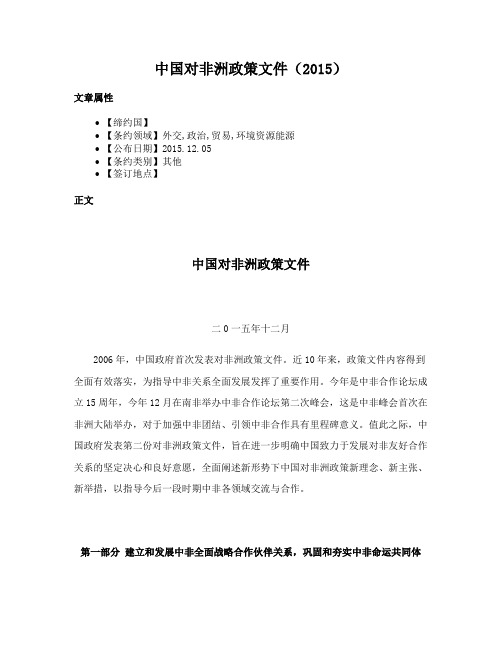
中国对非洲政策文件(2015)文章属性•【缔约国】•【条约领域】外交,政治,贸易,环境资源能源•【公布日期】2015.12.05•【条约类别】其他•【签订地点】正文中国对非洲政策文件二0一五年十二月2006年,中国政府首次发表对非洲政策文件。
近10年来,政策文件内容得到全面有效落实,为指导中非关系全面发展发挥了重要作用。
今年是中非合作论坛成立15周年,今年12月在南非举办中非合作论坛第二次峰会,这是中非峰会首次在非洲大陆举办,对于加强中非团结、引领中非合作具有里程碑意义。
值此之际,中国政府发表第二份对非洲政策文件,旨在进一步明确中国致力于发展对非友好合作关系的坚定决心和良好意愿,全面阐述新形势下中国对非洲政策新理念、新主张、新举措,以指导今后一段时期中非各领域交流与合作。
第一部分建立和发展中非全面战略合作伙伴关系,巩固和夯实中非命运共同体中非从来都是命运共同体。
半个多世纪以来,无论国际风云如何变幻,中非始终是风雨同舟的好朋友、休戚与共的好伙伴、肝胆相照的好兄弟。
中非传统友好深得人心,已成为中非双方的宝贵财富。
长期以来,中非双方坚持真诚友好、平等相待,这是中非关系历久弥坚的精神内核。
新形势下,中非双方将在此基础上,致力于合作共赢、共同发展,为中非关系赋予新的内涵,注入不竭动力。
2006年中国政府提出中非建立和发展政治上平等互信、经济上合作共赢、文化上交流互鉴的新型战略伙伴关系。
10年来,双方共同制订并落实了一系列深化中非合作的重大举措,极大地促进了中非各领域友好合作关系快速发展。
中非政治互信进一步增强,在国际和地区事务中协调与配合更加紧密。
中非务实合作成果丰硕。
中国自2009年起成为非洲第一大贸易伙伴国,2014年中国对非贸易额增至2006年的4倍。
中非人文交流快速增长,中非人员往来每年近300万人次,中非友好的社会和民意基础进一步扩大。
中非交往与合作的广度和深度前所未有,中国对非洲经济发展的贡献率显著提升。
共同绘就新蓝图携手扬帆再起航——持续推动中非经贸合作向更高水平发展
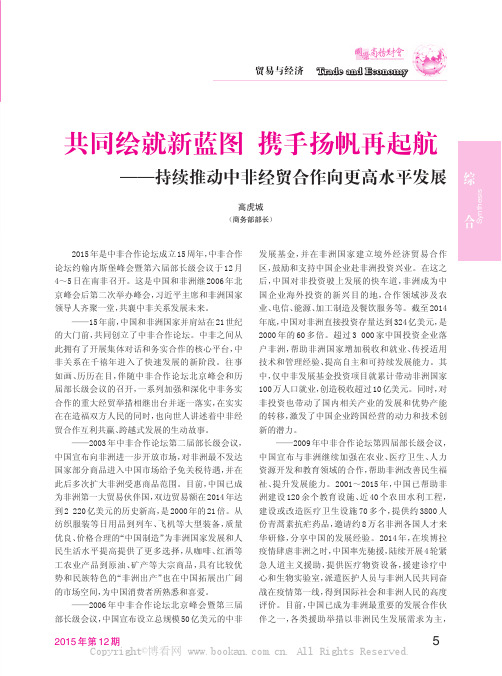
2015年是中非合作论坛成立15周年,中非合作论坛约翰内斯堡峰会暨第六届部长级会议于12月4~5日在南非召开。
这是中国和非洲继2006年北京峰会后第二次举办峰会,习近平主席和非洲国家领导人齐聚一堂,共襄中非关系发展未来。
——15年前,中国和非洲国家并肩站在21世纪的大门前,共同创立了中非合作论坛。
中非之间从此拥有了开展集体对话和务实合作的核心平台,中非关系在千禧年进入了快速发展的新阶段。
往事如画、历历在目,伴随中非合作论坛北京峰会和历届部长级会议的召开,一系列加强和深化中非务实合作的重大经贸举措相继出台并逐一落实,在实实在在造福双方人民的同时,也向世人讲述着中非经贸合作互利共赢、跨越式发展的生动故事。
——2003年中非合作论坛第二届部长级会议,中国宣布向非洲进一步开放市场,对非洲最不发达国家部分商品进入中国市场给予免关税待遇,并在此后多次扩大非洲受惠商品范围。
目前,中国已成为非洲第一大贸易伙伴国,双边贸易额在2014年达到2220亿美元的历史新高,是2000年的21倍。
从纺织服装等日用品到列车、飞机等大型装备,质量优良、价格合理的“中国制造”为非洲国家发展和人民生活水平提高提供了更多选择,从咖啡、红酒等工农业产品到原油、矿产等大宗商品,具有比较优势和民族特色的“非洲出产”也在中国拓展出广阔的市场空间,为中国消费者所熟悉和喜爱。
——2006年中非合作论坛北京峰会暨第三届部长级会议,中国宣布设立总规模50亿美元的中非发展基金,并在非洲国家建立境外经济贸易合作区,鼓励和支持中国企业赴非洲投资兴业。
在这之后,中国对非投资驶上发展的快车道,非洲成为中国企业海外投资的新兴目的地,合作领域涉及农业、电信、能源、加工制造及餐饮服务等。
截至2014年底,中国对非洲直接投资存量达到324亿美元,是2000年的60多倍。
超过3000家中国投资企业落户非洲,帮助非洲国家增加税收和就业、传授适用技术和管理经验、提高自主和可持续发展能力。
中非合作论坛第五届部长级会议
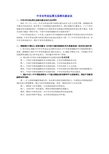
中非合作论坛第五届部长级会议一、中非合作论坛第五届部长级会议在北京举行2012年7月19日,中非合作论坛第五届部长级会议在人民大会堂开幕。
胡锦涛出席开幕式并发表讲话。
南非等9个非洲国家及政府领导人、联合国秘书长潘基文、50个同中国建交的非洲国家部长、非盟委员会主席和部分非洲地区和国际组织代表出席开幕式。
本届会议的主题是“继往开来,开创中非新型战略伙伴关系新局面”。
中非合作论坛创立12年来,已成为中非开展集体对话的重要平台和进行务实合作的有效机制。
中非合作论坛第五届部长级会议是论坛发展步入第二个十年召开的首次部长会,对中非关系承前启后、继往开来具有重要意义。
二、胡锦涛在开幕式上发表的题为《开创中非新型战略伙伴关系新局面》讲话的主要内容1.充分肯定2006年中非合作论坛北京峰会以来6年中非新型战略伙伴关系取得的重大进展。
强调指出2011年中非贸易额达到1663亿美元,比2006年增加2倍。
中国累计对非直接投资金额已达150多亿美元,项目遍及非洲50个国家。
2.提出努力开创中非新型战略伙伴关系新局面的五点主张第一,开创中非新型战略伙伴关系新局面,中非应该增强政治互信;第二,开创中非新型战略伙伴关系新局面,中非应该拓展务实合作;第三,开创中非新型战略伙伴关系新局面,中非应该扩大人文交流;第四,开创中非新型战略伙伴关系新局面,中非应该密切在国际事务中的协调和配合;第五,开创中非新型战略伙伴关系新局面,中非应该加强合作论坛建设。
3.提出今后3年中国政府将在5个重点领域支持非洲和平与发展事业,推进中非新型战略伙伴关系。
第一,扩大投资和融资领域合作,为非洲可持续发展提供助力。
中国将向非洲国家提供200亿美元贷款额度,重点支持非洲基础设施、农业、制造业和中小企业发展。
第二,继续扩大对非援助,让发展成果惠及非洲民众。
第三,支持非洲一体化建设,帮助非洲提高整体发展能力。
第四,增进中非民间友好,为中非共同发展奠定坚实民意基础。
九年级政治
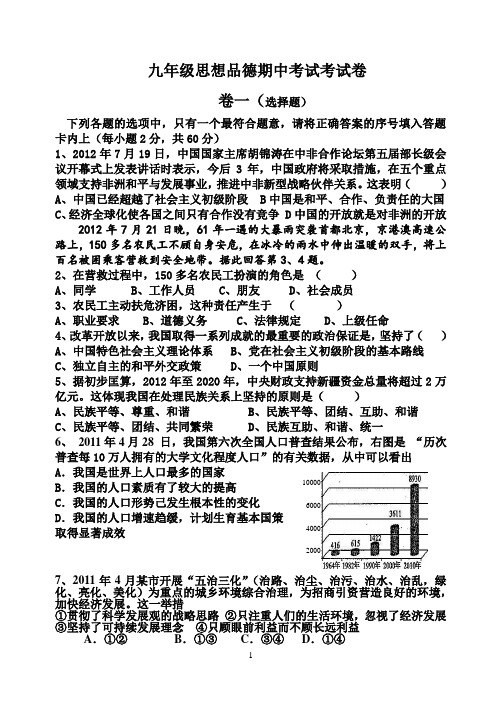
10000 60004000 2000 九年级思想品德期中考试考试卷卷一(选择题)下列各题的选项中,只有一个最符合题意,请将正确答案的序号填入答题卡内上(每小题2分,共60分)1、2012年7月19日,中国国家主席胡锦涛在中非合作论坛第五届部长级会议开幕式上发表讲话时表示,今后3年,中国政府将采取措施,在五个重点领域支持非洲和平与发展事业,推进中非新型战略伙伴关系。
这表明( )A 、中国已经超越了社会主义初级阶段B 中国是和平、合作、负责任的大国C 、经济全球化使各国之间只有合作没有竞争D 中国的开放就是对非洲的开放2012年7月21日晚,61年一遇的大暴雨突袭首都北京,京港澳高速公路上,150多名农民工不顾自身安危,在冰冷的雨水中伸出温暖的双手,将上百名被困乘客营救到安全地带。
据此回答第3、4题。
2、在营救过程中,150多名农民工扮演的角色是 ( )A 、同学B 、工作人员C 、朋友D 、社会成员3、农民工主动扶危济困,这种责任产生于 ( )A 、职业要求B 、道德义务C 、法律规定D 、上级任命4、改革开放以来,我国取得一系列成就的最重要的政治保证是,坚持了( )A 、中国特色社会主义理论体系B 、党在社会主义初级阶段的基本路线C 、独立自主的和平外交政策D 、一个中国原则5、据初步匡算,2012年至2020年,中央财政支持新疆资金总量将超过2万亿元。
这体现我国在处理民族关系上坚持的原则是( )A 、民族平等、尊重、和谐B 、民族平等、团结、互助、和谐C 、民族平等、团结、共同繁荣D 、民族互助、和谐、统一6、 2011年4月28 日,我国第六次全国人口普查结果公布,右图是 “历次普查每10万人拥有的大学文化程度人口”的有关数据,从中可以看出A .我国是世界上人口最多的国家B .我国的人口素质有了较大的提高C .我国的人口形势己发生根本性的变化D .我国的人口增速趋缓,计划生育基本国策取得显著成效7、2011年4月某市开展“五治三化”(治路、治尘、治污、治水、治乱,绿化、亮化、美化)为重点的城乡环境综合治理,为招商引资营造良好的环境,加快经济发展。
- 1、下载文档前请自行甄别文档内容的完整性,平台不提供额外的编辑、内容补充、找答案等附加服务。
- 2、"仅部分预览"的文档,不可在线预览部分如存在完整性等问题,可反馈申请退款(可完整预览的文档不适用该条件!)。
- 3、如文档侵犯您的权益,请联系客服反馈,我们会尽快为您处理(人工客服工作时间:9:00-18:30)。
中非合作论坛第五届部长级会议——北京行动计划(2013年至2015年)1. 序言2. 政治和地区和平与安全2.1高层互访与对话2.2磋商与合作机制2.3立法机构、政党、地方政府等交往2.4领事、司法合作2.5中国与非洲联盟及非洲次区域组织的合作2.6和平与安全领域合作3. 国际事务中的合作4. 经济领域合作4.1农业与粮食安全4.2投资与企业合作4.3基础设施建设4.4贸易4.5金融和银行业4.6能源资源合作4.7信息通讯4.8交通4.9旅游5.发展领域合作5.1援助5.2人力资源开发5.3科技合作与知识共享5.4减贫合作5.5医疗卫生5.6应对气候变化与环境治理6. 人文交流与合作6.1文化6.2教育6.3新闻出版与媒体6.4学者与智库6.5民间与青年、妇女交流6.6体育7. 中非合作论坛1. 序言1.12012年7月19日至20日,中非合作论坛第五届部长级会议在中国北京召开。
来自中国和50个非洲国家的外交部长和负责经济合作事务的部长、非洲联盟委员会主席出席了会议。
1.2中非双方高度评价中非合作论坛成立12年来为巩固中非传统友好、加强政治互信、深化务实合作、促进交流互鉴,推进中非新型战略伙伴关系全面发展作出的积极贡献。
1.3双方满意地回顾了中非合作论坛第四届部长级会议召开近三年来各项后续行动落实情况,对2009年11月在埃及召开的论坛第四届部长级会议通过的《中非合作论坛——沙姆沙伊赫行动计划(2010年至2012年)》得到全面、有效执行感到高兴,重申将继续从战略高度和长远角度看待中非关系发展,不断深化中非新型战略伙伴关系。
1.4为落实会议成果,规划今后三年中非在各领域的合作,围绕“继往开来,开创中非新型战略伙伴关系新局面”的主题、本着本届部长会《北京宣言》精神,双方共同制定并一致通过本行动计划。
2. 政治和地区和平与安全2.1高层互访与对话重申高层互访与对话对促进双边关系发展、深化中非新型战略伙伴关系具有十分重要的意义。
同意继续保持中非领导人互访和对话势头,增进政治互信、扩大战略共识。
2.2 磋商与合作机制2.2.1赞赏中非多种形式的对话机制不断丰富和加强,同意继续完善中国与非洲国家双边委员会、战略对话、外交部政治磋商、经贸联(混)合委员会等机制建设,加强对中国和非洲国家关系的规划和指导。
2.2.2继续加强双方在联合国、国际金融机构和其他国际场合的交流与合作,密切在重大国际与地区问题上的协调与配合,维护发展中国家共同利益。
2.2.3赞赏中非外长级政治磋商机制顺利发展,强调这一机制对加强中非关系战略规划,促进双方在重大国际和地区问题上的沟通与合作具有重要意义。
同意于2013年联合国大会之际举行第三次中非外长级政治磋商,就共同关心的重大问题交换意见。
2.3立法机构、政党、地方政府等交往2.3.1继续扩大中国全国人民代表大会与非洲国家议会、泛非议会的交流与合作,充分发挥各自优势和影响,为巩固中非传统友好、促进互利合作营造有利的环境。
2.3.2支持中国人民政治协商会议及中国经济社会理事会与非洲经社理事会联盟及非洲各国经社理事会和类似组织增进了解,扩大交流与合作,推动双方关系进一步发展。
2.3.3不断拓展和丰富党际交往的范围和形式,深化政治对话,巩固政治互信,扩大治国理政和发展经验交流,推动务实合作。
2.3.4进一步加强中非地方政府交流与合作,决定适时举办“中非地方政府合作论坛”,积极支持双方广泛建立友好省市关系。
2.4领事、司法合作2.4.1加强领事合作、开展领事磋商,为便利双方人员往来创造更为有利的条件,继续共同努力打击非法移民活动。
2.4.2采取切实和必要措施,保障在本国境内对方人员和企业的人身和财产、资产安全与权益。
2.4.3加强双方在司法、执法和立法领域内的交流与合作,包括依据双边条约和多边公约预防、打击跨国有组织犯罪。
2.4.4赞赏中非合作论坛第四届部长级会议倡议建立“中非合作论坛——法律论坛”并于2009年12月在开罗、2010年9月在北京成功举办两届论坛会议。
同意进一步加强该机制建设,加强双方在法学研究、法律服务、法律人才培训以及非诉讼纠纷解决机制等领域的合作。
2.5中国与非洲联盟及非洲次区域组织的合作2.5.1认识到非盟在维护非洲和平与稳定、促进非洲发展、推动非洲一体化进程方面发挥的重要作用,支持非盟在国际和地区事务中发挥更大作用和影响。
2.5.2赞赏中国与非盟关系全面发展,同意保持双方高层交往势头,加强战略互信和务实合作,密切在国际和地区事务中的协调配合,不断推动双方关系向更高水平发展。
2.5.3非方感谢中国政府援建非盟会议中心、宣布自2012年起3年内向非盟提供6亿元人民币无偿援助等一系列加强中国与非盟务实合作的举措,认为这充分体现了中国对非洲一体化进程和联合自强的坚定支持。
双方愿共同做好有关举措的落实工作。
2.5.4满意地看到,中国与非盟战略对话机制运行良好并取得积极成果。
同意继续充实和完善该战略对话机制,并在该机制框架下开展包括但不局限于外交政策、和平与安全事务的分组对话。
2.5.5欢迎非盟委员会加入中非合作论坛,同意加强中国与非盟在中非合作论坛框架下的对话、磋商与合作。
2.5.6为促进双方关系,中方欢迎非盟适时在北京设立代表处。
2.5.7双方重视“非洲发展新伙伴计划”(NEPAD)在促进非洲发展和一体化方面的作用,赞赏中非合作论坛与“非洲发展新伙伴计划”开展的合作。
中方愿与“非洲发展新伙伴计划”规划协调局加强交流、扩大合作,共同促进非洲经济社会发展和地区经济融合。
2.5.8中国政府将继续加强与非盟和非洲次区域组织在泛非大学、非洲跨国跨区域基础设施建设等领域的务实合作,加大对非洲一体化建设的支持力度。
2.5.9中国政府将继续通过人力资源开发等多种方式,加大对非盟和非洲次区域组织能力建设的支持。
2.5.10注意到中国与非洲次区域组织保持良好关系与交流势头,同意建立和完善双方交流对话机制。
2.6和平与安全领域合作2.6.1双方认为当前非洲和平与安全面临的挑战增多,重申致力于在平等和相互尊重的基础上,加强在政策协调、能力建设、预防性外交、维和行动、冲突后重建等方面的合作,共同维护非洲和平与稳定。
中方将继续支持非洲国家打击轻、小武器非法贸易和流通的努力。
2.6.2赞赏非洲国家和地区组织在解决本地区问题上的主导作用,重申支持其为自主解决地区冲突、加强民主和良政建设所作的努力,反对外部势力出于自身利益干涉非洲内部事务。
2.6.3为加强与非洲在和平与安全事务中的合作,中方将发起“中非和平安全合作伙伴倡议”,在力所能及的范围内对非盟的支持和平行动,“非洲和平与安全框架”建设,和平与安全领域人员交流与培训,非洲冲突预防、管理与解决以及冲突后重建与发展提供资金和技术支持。
2.6.4重申联合国与非盟在非洲和平与安全领域加强交流与合作的重要意义。
中方将继续支持联合国在帮助解决非洲地区冲突问题上发挥建设性作用,积极参与联合国在非洲的维和行动,加强中非双方在联合国安理会的沟通与协调。
2.6.5赞赏中国政府非洲事务特别代表积极参与调解非洲热点问题的努力,欢迎其继续在非洲和平与安全事务中发挥建设性作用。
2.6.6非方赞赏中方根据联合国安理会有关决议在亚丁湾和索马里海域打击海盗的努力,鼓励中方扩大在该方面的努力。
重申此举有助于维护相关海域的航道安全及该地区的和平与安全。
中方愿加强同索马里以及非盟和相关非洲次区域组织在这一领域的合作。
3. 国际事务中的合作3.1共同维护《联合国宪章》宗旨和原则、和平共处五项原则及其他公认的国际关系准则,推动国际秩序向着公正合理的方向发展。
3.2共同维护联合国在国际事务中的核心作用,促进多边主义和国际关系民主化。
重申有必要对联合国进行改革,重申应解决非洲国家遭受的历史不公,优先增加非洲国家在联合国安理会和其他机构的代表性。
3.3对当前国际金融危机蔓延深化、世界经济形势依然严峻表示担忧,呼吁国际社会关注和尽量减少危机对发展中国家特别是最不发达国家造成的损害。
共同推动国际金融体系朝着公平、公正、包容、有序的方向发展。
主张增加非洲在国际货币基金组织和世界银行等国际金融机构的发言权和代表性。
支持二十国集团加强与非洲的对话,支持非洲参与二十国集团事务。
非方强调增强二十国集团等现有国际经济机制代表性的迫切需要。
中方完全理解非方诉求,并强调现有国际经济秩序应实现平衡,以保证非洲国家的公平代表性。
3.4共同推动国际社会认真落实2010年9月召开的联合国千年发展目标高级别会议及2012年6月召开的联合国可持续发展大会成果,呼吁国际社会更多关注非洲等发展中国家可持续发展问题,特别是发达国家尽快兑现援助、减债等承诺,提供更多资金支持、外国直接投资和技术转让,帮助非洲国家加强能力建设,尽早实现千年发展目标。
中非双方呼吁国际社会在联合国的领导下,展现寻求共识的政治诚意和承诺,就后千年发展目标可持续发展框架的实施计划达成一致。
3.5继续开展应对气候变化方面的合作。
共同推动国际社会根据2011年底成功举行的南非德班气候变化大会的有关精神,继续坚持《联合国气候变化框架公约》及其《京都议定书》和“巴厘路线图”授权,坚持公平和“共同但有区别的责任”原则,推动有关各方切实履行加强行动德班平台、《京都议定书》第二承诺期、绿色气候基金、技术机制和适应等方面的共识,共同推动气候变化国际合作进程。
3.6共同推动世界贸易组织多哈发展回合谈判早日取得进展并切实照顾发展中国家特别是最不发达国家的利益和关切。
强调多哈回合谈判十年谈判成果必须得到维护,有关谈判必须坚持一揽子协议。
3.7共同推动国际社会采取积极有效的协调措施,稳定粮价,防止投机和炒作,并在资金、技术、市场、能力建设等方面加大对非洲国家的支持,维护世界粮食安全。
3.8加强双方在人权领域的对话和交流。
重申尊重人权的普遍性原则,支持各国根据自身国情选择合适的人权发展道路,优先关注发展权。
反对将人权问题政治化和设立双重标准。
3.9加强双方在打击一切形式恐怖主义方面的沟通与合作,主张综合施策、标本兼治,推动国际反恐合作不断取得新进展。
支持联合国及其安理会在国际反恐合作中发挥主导作用,并帮助非洲国家提高反恐能力。
4. 经济领域合作4.1农业与粮食安全4.1.1注意到非洲国家面临的粮食安全问题尤为突出,强调农业发展对保障非洲粮食安全至关重要。
决定继续将农业和粮食安全作为合作的优先领域。
4.1.2积极评价双方长期以来在农业和粮食安全领域所取得的重要合作成果。
4.1.3赞赏非洲国家在“非洲农业全面发展计划”框架下实施以增长为中心的农业规划取得的进展,承诺支持“非洲农业全面发展计划”。
4.1.4承诺将开展多层次、多渠道、多形式的农业合作与交流。
